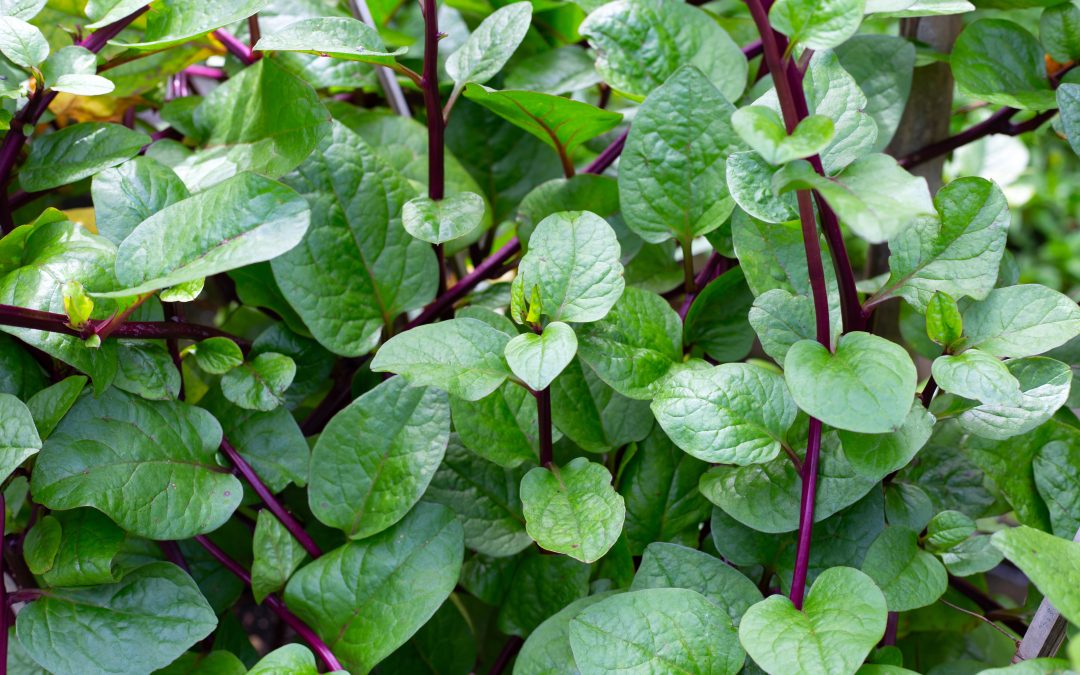
by Molly Jameson | May 15, 2025
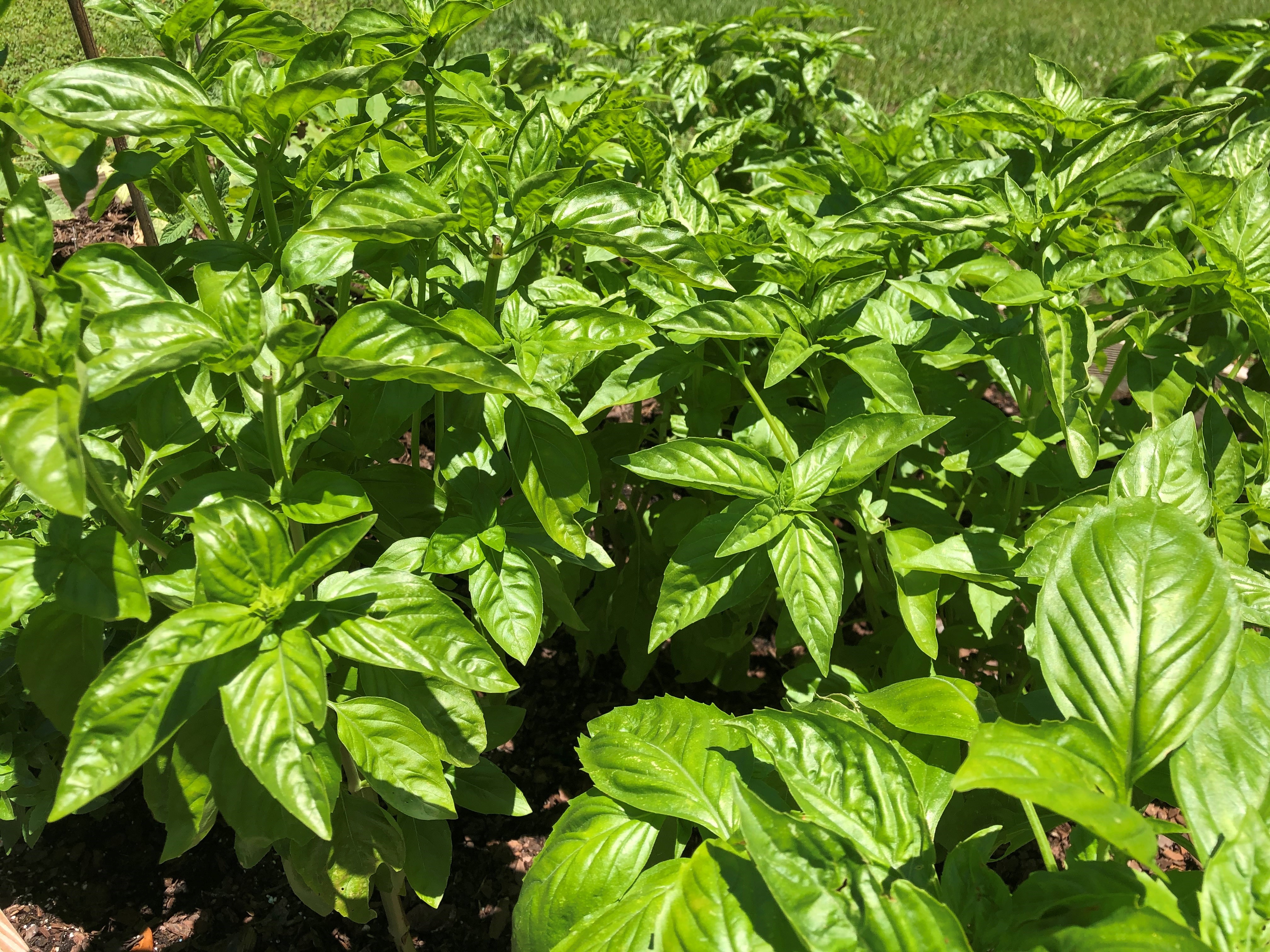
Sweet summer basil thrives in the heat – regular harvesting encourages bushier growth and delays flowering. Photo by Molly Jameson.
As the weather heats up, many spring vegetables begin to bolt, wilt, or shut down entirely. But for gardeners willing to shift gears, summer presents an opportunity to grow a new cast of crops that thrive in high temperatures, intense sun, and even occasional drought. Whether you’re growing in raised beds, in-ground rows, or large containers, these heat-loving vegetables are well-suited to our long summer season in the Panhandle.
Here are some of the best summer veggies to keep your garden productive when the thermometer climbs:
Okra
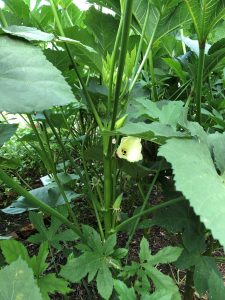
Okra thrives in the summer heat, producing edible pods just days after flowering. Photo by Molly Jameson.
Okra is a true warm-season crop that thrives in the heat and even tolerates periods of drought. For better germination, soak seeds in water for several hours or overnight before planting. Sow seeds directly into the garden once soil temperatures are at least 65°F and the danger of frost has passed – typically from late March through July. Plant seeds 1 inch deep and 4 to 6 inches apart in rows spaced 3 feet apart. Once seedlings are several inches tall, thin them so the remaining plants are spaced 1.5 to 2 feet apart. Pick pods when they’re two to four inches long, usually within a few days of flowering, to avoid tough, fibrous texture. Regular harvesting encourages more production throughout the summer.
Okra varieties well suited for our area include ‘Clemson Spineless’ and ‘Emerald,’ both known for their productivity and tender pods.
Southern Peas
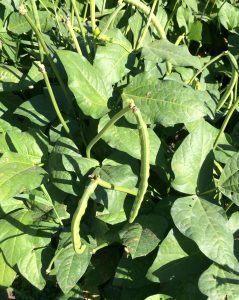
‘Zipper Cream’ southern peas are heat-tolerant and productive, with easy-to-shell pods and creamy, mild flavor. Photo by Molly Jameson.
Also known as cowpeas or field peas, southern peas are a staple crop across the South for good reason – they tolerate heat, sandy soil, and inconsistent rain. Sow seeds directly in June through August, spacing them about 2 to 4 inches apart in rows 18 to 30 inches apart, depending on the variety. Southern peas are nitrogen fixers, so they can improve soil fertility over time.
Popular southern pea varieties include ‘Pinkeye Purple Hull,’ ‘California Black-eyed,’ ‘Creel Crowder,’ and ‘Zipper Cream.’ These plants are also relatively pest- and disease-resistant, making them a great low-maintenance option.
Sweet Potatoes
Sweet potatoes are grown from slips – vine cuttings taken from sprouted tubers. These slips should be planted after the danger of frost has passed and soil temperatures are consistently above 65°F, typically April through June. Space slips about 12 to 18 inches apart in loose, well-drained soil. While mounding isn’t always necessary, creating raised ridges or planting in raised beds can help promote tuber development and improve drainage, especially in heavier or poorly drained soils. Sweet potatoes require a long growing season – around 90 to 120 days – but they produce abundantly and require minimal care once established. Their vines also form a dense ground cover that suppresses weeds and reduces soil erosion.
Two reliable sweet potato varieties for Florida gardens are ‘Centennial’ and ‘Beauregard,’ both known for their sweet flavor, high yields, and adaptability to southern growing conditions.
Malabar Spinach
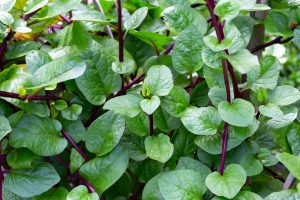
Red-stemmed Malabar spinach thrives in summer heat, producing tender, edible leaves on vigorous climbing vines. Photo by Bowonpat, Adobe Stock.
Malabar spinach is not a true spinach, but it provides tender, edible leaves throughout the hot months when traditional greens fail. It grows as a climbing vine, so give it a trellis or support to climb. Sow seeds directly into the garden or transplant young seedlings from mid-April through early June. This plant enjoys both sun and partial shade, and its thick, glossy leaves can be harvested regularly for salads or to thicken soups and stews. Just like regular spinach, frequent picking promotes new growth.
Both red-stemmed and green-stemmed Malabar spinach types are available, with the red-stemmed variety more commonly grown for its ornamental appeal.
Basil
Basil is a heat-tolerant herb that loves full sun and thrives in the warmth of summer. It can be direct-seeded or transplanted once the weather settles into consistent warmth, typically March through May in North Florida. Space plants about 10 to 12 inches apart and harvest often to prevent flowering and promote bushier growth.
In addition to classic sweet basil, try Thai basil or lemon basil for unique flavors that hold up in hot dishes and drinks alike.
Peppers
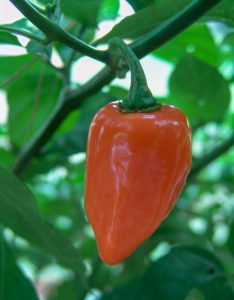
Habanero plants yield intensely hot peppers with a distinct tropical flavor. Photo by Gerald Holmes, Strawberry Center, Cal Poly San Luis Obispo, Bugwood.org.
Peppers – especially hot varieties – are well-adapted to Florida summers, although they benefit from a bit of afternoon shade during the most intense heat. Start with healthy transplants in spring or early summer, spacing them 18 to 24 inches apart. Keep the soil consistently moist and apply mulch to help retain moisture.
For sweet pepper options, try ‘Corno di Toro’ or ‘Sweet Banana.’ For heat lovers, datils, jalapeños, and habaneros all perform well in warm conditions. Just note that some varieties may slow production during extreme heat, then pick up again as temperatures moderate.
Take a Break with a Cover Crop
If summer gardening starts to feel overwhelming, you don’t have to plant every square foot. Consider giving part of your garden a seasonal rest with a warm-season cover crop like cowpeas, velvet beans, buckwheat, or even sweet potatoes. These vigorous growers help suppress weeds, improve soil structure, and add organic matter – and in the case of legumes like cowpeas and velvet beans, they also fix nitrogen to benefit future crops. Sweet potatoes, while edible, can also serve double duty as a weed-smothering ground cover.

Sweet potato vines form a dense summer ground cover that suppresses weeds and protects the soil. Photo by Janis Piotrowski.
For a lower-maintenance splash of color, consider heat-loving flowers like sunflowers, French marigolds, or zinnias – all of which attract pollinators and beneficial insects while brightening up your garden space.
Don’t let the summer heat bring your garden to a standstill! By choosing vegetables that are naturally adapted to our hot, humid conditions, you can keep your garden thriving and productive all season long.
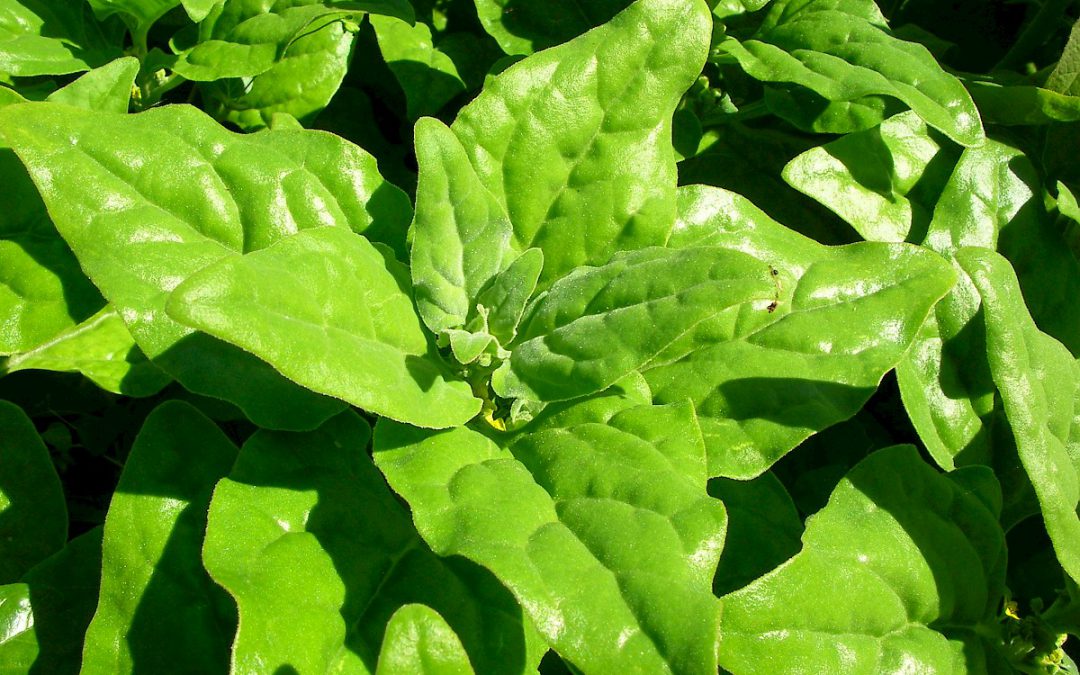
by Molly Jameson | Mar 2, 2023

New Zealand spinach has a mild flavor, flourishes in the heat, and can serve as a nutritious summer salad. Photo by Forest and Kim Starr.
If you’ve ever tried growing lettuce (Lactuca sativa), true spinach (Spinacia oleracea), or crops in the cabbage family (Brassica spp.) in late spring or summer in the subtropics of Florida, you know that our extreme heat can make it difficult. Between bolting leaves, fungal diseases, insect pressure, and poor germination, it can be quite a challenge to keep greens on the dinner table all year long.
Fortunately, there are a few greens that – while less well known – can take our Florida heat and are relatively easy to grow. Some of these greens include New Zealand spinach, Malabar spinach, and perpetual spinach. They are frost sensitive and prefer well-drained, slightly acidic soil and require regular watering, but they don’t need a lot of fertilizer or special attention. Additionally, they are resistant to most pests and diseases.
New Zealand Spinach
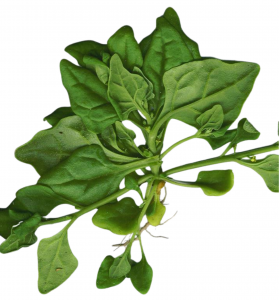
New Zealand spinach tastes similar to true spinach but can stand up to the Florida heat. Photo by Forest and Kim Starr, Starr Environmental, Bugwood.org.
New Zealand spinach (Tetragonia tetragonioides) is a leafy green that is native to New Zealand, but it is well-adapted to warm climates such as ours. It grows one to two feet in height and branches two to three feet across. In the kitchen, it is known for its mild, slightly salty flavor, and it is a great source of vitamins A and C, iron, and calcium.
New Zealand spinach germinates slowly, taking two to three weeks to sprout. Soaking seeds for 24 hours directly before planting can help them along, but be patient, and keep the planted area weed free.
Sow seeds a quarter-inch deep, two inches apart, and water well, keeping the soil moist but not waterlogged. Once germinated, thin to eight to 12 inches apart. After the plant has grown about a foot, harvest a few tender leaves off of each branch, making sure enough leaves remain so the plant can continue to photosynthesize and grow.
Read the UF/IFAS publication Spinach, New Zealand to learn more about growing New Zealand spinach.
Malabar Spinach
Malabar spinach (Basella alba and B. cordifolia) is a fast-growing leafy vine native to tropical South Asia. It is known for its thick, succulent leaves and its slightly lemony flavor. It is a good source of antioxidants, vitamins A and C, iron, and calcium.
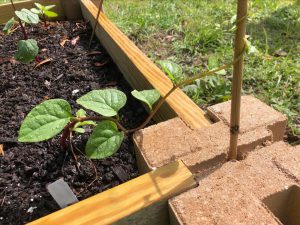
Support fast-growing Malabar spinach vines with a trellis or stakes. Photo by Molly Jameson.
Like New Zealand spinach, Malabar spinach is vulnerable to frosts and grows well in hot, humid conditions. Wait until soil temperatures reach 65°F to 75°F to sow or wait at least three weeks after the last frost date. Typically, in our area, it does best sown from mid-April through early June.
Sow seeds a quarter-inch deep, two inches apart. Also, like New Zealand spinach, Malabar spinach can take two to three weeks to germinate, so soaking seeds for 24 hours prior to planting is recommended. Once planted, keep the area weed free and well-watered, but not waterlogged.
After germination, thin the sprouts out so that they are spaced 12 inches apart. In optimal conditions, the plant can reach maturity in 70 days. Vines will continue to grow to 10 feet or longer and will benefit from a trellis, a fence, or stakes to assist in climbing. Harvest the leaves and young stems and prune back any overlong vines.
Read the UF/IFAS publication Florida Cultivation Guide for Malabar Spinach to learn more about growing Malabar spinach.
Perpetual Spinach
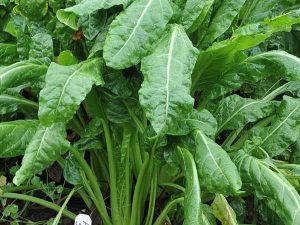
Perpetual spinach is related to Swiss chard and beets, but it is more “spinach-like” in flavor. Photo by Baker Creek Heirloom Seed Company.
Perpetual spinach (Beta vulgaris), or spinach beet, is a leafy green that is the same species as Swiss chard and beets, but tastes more like a true spinach and is known for its mild, slightly sweet flavor. It is a great source of vitamins A, C, and K, as well as calcium, magnesium, and iron.
Perpetual spinach can tolerate cooler temperatures than New Zealand and Malabar spinach, but it also grows well in warm weather and can continue to produce throughout the growing season.
Sow seeds a half-inch inch deep, two inches apart. Water well and keep the soil moist but not waterlogged. Again, be patient, as like the other heat-loving greens, perpetual spinach can take up to two to three weeks to germinate.
Once the plants have sprouted, thin them out so that they are spaced six to eight inches apart. Begin harvesting by cutting leaves at the base of the stem. If the plants get too big or the leaves begin to taste bitter, cut the leaves back to about three inches above the soil and they will produce new, tender leaves.
Learn more about perpetual spinach through the NC State Extension’s Beta vulgaris Plant Toolbox page or the University of Hawaii fact sheet Perpetual Spinach (Beta vulgaris L. Cicla group).
While these heat-loving greens do not taste the same as lettuce, true spinach, kale, or collards, they are incredibly versatile in the kitchen and have a unique flavor profile. They can be eaten raw in salads, or they can be cooked in a variety of dishes. For example, New Zealand spinach can be sautéed with garlic and lemon juice, while Malabar spinach can be used as a green in a delicious stir-fry. Perpetual spinach can be used in soups, stews, casseroles, and salads.
Other heat-loving greens to try out in the garden include Okinawa spinach (Gynura crepioides), longevity spinach (Gynura procumbens), and Surinam spinach (Talinum triangulare).
If you are looking to keep homegrown greens on the dinner table this spring and summer, give heat-loving greens a try! They are easy to grow, resistant to pests and diseases, and are great additions to many dishes.
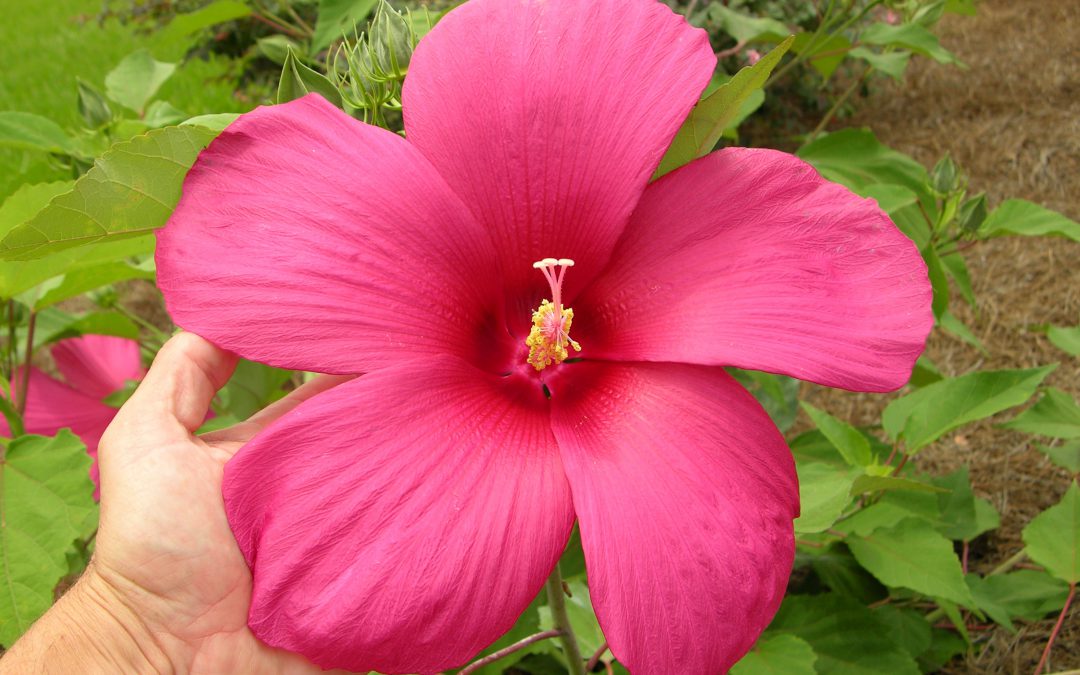
by Gary Knox | Jul 30, 2020
The dog days of summer are here with high temperatures and humidity. While this sultry weather forces humans to retreat to air conditioning, our gardens suffer because the high night temperatures cause temperate plants to stop flowering, lose vigor and pause growth. By August, many plants in the garden look as bedraggled and wilted as we feel after mowing the grass or trying to weed.
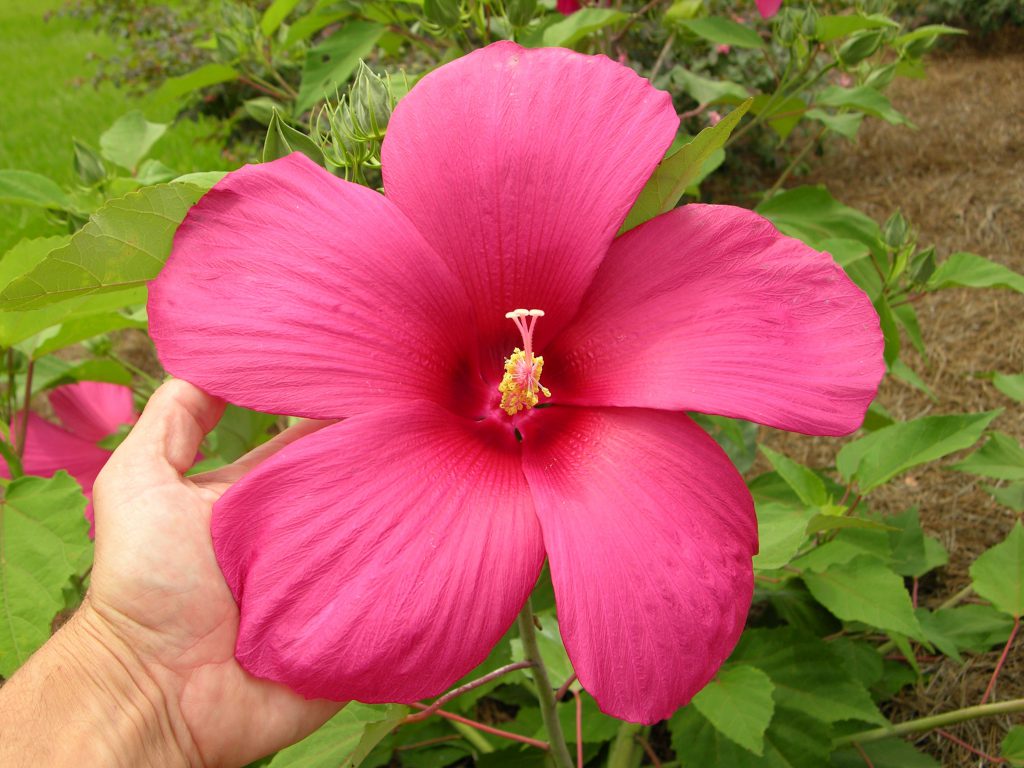
‘Moy Grande’ Hardy Hibiscus (Hibiscus spp.)
All is not lost: the fading flowers and fizzling foliage of traditional garden plants can give way to heat-loving tropicals! Plants that are native to tropical and subtropical climates are naturally adapted to heat, humidity and rain, easily standing up to the worst that our north Florida summers can throw at them. Tropicals offer bright flowers, bold texture and exuberant growth just when the rest of your garden melts in the heat. Tropical plants include trees, shrubs, vines, perennials, groundcovers or annuals, and there are tropicals for full sun, part sun or shade.
Tropical Plants for North Florida
Top tropicals for north Florida gardens are palms, bananas, hibiscus, and gingers. Palms are the iconic symbol of the Tropics. Native subtropical palms can give you the palm vibe without the worry of cold hardiness. These include cabbage palm and related palmettos in the genus Sabal, paurotis palm (Acoelorrhaphe wrightii), saw palmetto (Serenoa repens) and needle palm (Rhapiophyllum hystrix). Non-native European fan (Chamaerops humilis), jelly (Butia spp.), windmill (Trachycarpus spp.), date (Phoenix spp.), Washington (Washingtonia spp.) and other palms also grow well and are cold hardy in north Florida. Most palms grow best in full to part sun but palmettos, saw palmetto and needle palm can handle more shade. Saw palmetto, needle palm and most palmettos grow 3 to 6 ft. tall. European fan, jelly, paurotis and windmill palms grow 10 to 20 ft. tall, while cabbage, Washington and date palms often exceed 40 ft. For best appearance, palms often require special fertilizer (https://edis.ifas.ufl.edu/ep261).
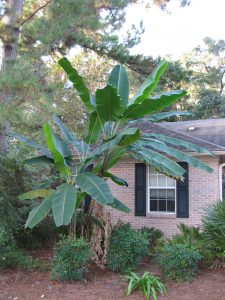
Hardy Yunnan Banana (Musa yunnanensis)
Characterized by their large, bold leaves, bananas are another plant group associated with tropical weather and full sun. Hardier forms of banana that thrive here include Chinese yellow (Musella lasiocarpa), pink (M. velutina), basjoo (Musa basjoo), Yunnan (M. itinerans), and hardy Yunnan (M. yunnanensis). Chinese yellow and pink bananas grow about 5 ft. or more in height, whereas the others have mature heights of 20 ft. or more. Bananas benefit from planting in a location that blocks strong winds so as not to shred the leaves. Depending on the severity of our winter, these bananas may lose some or all leaves but they usually regrow in late spring once warm weather arrives.
The large, colorful and exotic-looking flowers of tropical hibiscus (Hibiscus rosa-sinensis) are associated with the tropics, though this hibiscus is less cold hardy here and is perhaps best enjoyed as a container plant. Other notable hibiscus for north Florida include Confederate rose (H. mutabilis), rose-of-sharon or althea (H. syriacus), and hardy hibiscus (many hybrids of H. moscheutos and other native species). Varying in height from 3 (hardy hibiscus) to 12 ft. (confederate rose), hibiscus thrives in full sun and moist, even wet, soil. Their summer flowers come in colors of white, lavender, pink and red and range in size from a few inches (althea) to the size of dinnerplates (hardy hibiscus)! Except for rose-of-sharon, these hibiscus die back in winter and re-emerge again in late spring.
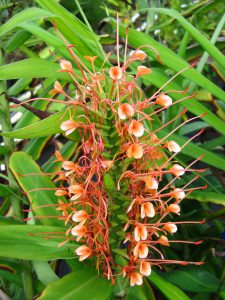
‘Disney’ Ginger Lily (Hedychium coccineum)
Gingers are also symbolic of the tropics. Many produce complex or colorful flowers and often flowers or other plant parts are aromatic. Ginger lily (Hedychium spp.), spiral ginger (Costus spp.) and shell ginger (Alpinia spp.) have fragrant and colorful racemes or spikes of flowers that appear at the tops of stems 4 ft. to 6 ft. or more tall. Hidden ginger (Curcuma spp.) and true ginger (Zingiber spp.) are lower growing with flowers appearing in “cones” on tops of separate, short stems. Finally, the patterned leaves of peacock ginger (Kaempferia spp.) make a beautiful summer groundcover. Gingers grow best in part sun to part shade.
There are many other tropical plants including coral tree (Erythrina × bidwillii and E. crista-galli), pride-of-barbados (Caesalpinia pulcherrima), fatsia (Fatsia japonica), selloum philodendron (Thaumatophyllum bipinnatifidum), canna lily (the non-invasive Canna × generalis hybrids), peregrina (Jatropha integerrima), elephant ear (non-invasive Alocasia spp. types), Begonia spp. (annual, angelwing and rhizomatous types) and Caladium selections. Bamboos have a tropical look, but many grow aggressively and may be invasive in north Florida. Two recommended clumping bamboos are common bamboo (Bambusa vulgaris; growing 15 ft or more tall) and Chinese garden bamboo (Drepanostachyum falcatum; growing 12 ft. or more tall).
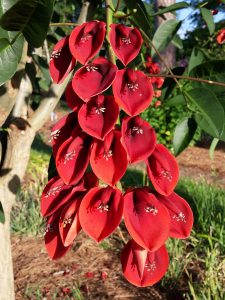
Cockspur Coral Tree (Erythrina crista-galli)
“Tropical” does not necessarily mean “non-native” as there are many Florida natives that provide summer color or texture and are heat loving yet cold hardy in north Florida. These include some palms (cabbage, palmetto, paurotis), ashe magnolia (Magnolia ashei), switchcane (Arundinaria gigantea, a native bamboo), hardy hibiscus (Hibiscus grandiflorus, H. moscheutos and others), golden canna (Canna flaccida), and maypop passionflower (Passiflora incarnata).
Disadvantages of Tropicals
Use of tropicals in your garden does have a downside. Most tropicals are water hogs and need regular irrigation. This isn’t a problem if our area experiences the normal patterns of summer thunderstorms. However, if we don’t receive regular rainfall, tropical plants create the burden of having to water them regularly or else their flowers wilt and leaves droop.
Another disadvantage of tropicals is the “off-season” appearance. Though they thrive in summer heat, they grow slowly during the cooler temperatures of spring and fall and some disappear altogether in winter. Some tropicals are not winter hardy in north Florida and must be replanted each year or undergo elaborate cold protection strategies to help them survive. Other tropicals will over-winter, but often are burned back by frosts, requiring labor to cut back the dead foliage and stems. Finally, tropicals usually require warm weather for growth to resume, and tropicals that die back will produce gaps in your landscape during winter, spring and early summer.
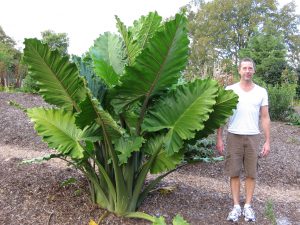
‘Portora’ Giant Elephant Ear (Alocasia sp.)
At the other extreme, some tropicals have such exuberant growth that they are invasive in north Florida. For example, almost all running types of bamboo and many clumping bamboos are invasive, other than those mentioned previously. Also avoid non-native canna (Canna indica), elephant ears (Colocasia and Xanthosoma spp.), Lantana (sterile forms are OK), and some non-native passionvines (Passiflora spp.). If you have questions about a plant’s invasiveness, check the UF/IFAS Assessment of Non-Native Plants in Florida’s Natural Areas, https://assessment.ifas.ufl.edu/.
Using Tropicals in North Florida
Tropicals are best used as accent plants to draw attention in summer when they look their best and the rest of the garden looks its worst. When used as accents, place them throughout the landscape so that winter damage or absences aren’t noticed. Concentrations of tropicals in one area will look great in summer but could look like a mass of dead foliage in winter! To create an entirely tropical-looking planting in north Florida, combine tropical plants with cold-hardy tropical lookalikes (a topic for another time!).
Plant tropicals in late spring once temperatures warm because they will grow slowly or even experience damage at temperatures below 50°F. Best practices for tropicals are to place them in the appropriate exposure for the particular plant (sun, part sun or shade) and keep them mulched. One common characteristic of tropicals is their need for soil moisture, necessitating irrigation to supplement rain. A rich soil or applications of organic mulches or compost can provide nutrients for growth, or light fertilizer applications in summer can boost growth.
Tropicals come alive in the heat of summer. When used in north Florida gardens, tropical plants provide pops of color, luxuriant growth and big, bold, dramatic texture that rescue our gardens from the doldrums of summer!
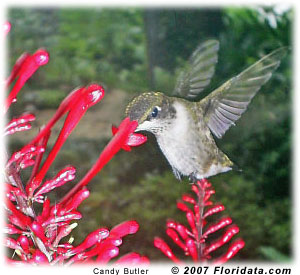
by Sheila Dunning | Jul 16, 2020

Dog Star nights Astro Bob
The “Dog Days” are the hottest, muggiest days of summer. In the northern hemisphere, they usually fall between early July and early September. The actual dates vary greatly from region to region, depending on latitude and climate. Life is so uncertain right now. But, fall is coming.
In ancient times, when the night sky was not obscured by artificial lights, the Romans used the stars to keep track of the seasons. The brightest constellation, Canis Major (Large Dog), includes the “dog star”, Sirius. In the summer, Sirius used to rise and set with the sun, leading the ancient Romans to believe that it added heat to the sun. Although the period between July 3 and August 11 is typically the warmest period of the summer, the heat is not due to the added radiation from a far-away star, regardless of its brightness. The heat of summer is a direct result of the earth’s tilt.
Spending time outdoors this time of year is uncomfortable, potentially dangerous, due to the intense heat. However, the chinch bugs are very active in St. Augustine grass (for more information: http://edis.ifas.ufl.edu/lh036), and the summer flowers need water. So, take care of those tasks early in the day and then retreat to the air conditioning to plan your fall planting.
Plant tomato plants in August for fruit in October. Varieties such as Phoenix, Florida 91, Solar Set and Heat Wave II are good selections for setting fruit in high temperatures, should summer temperatures continue. Otherwise, try some of the newer UF/IFAS recommended varieties for fall planting in North Florida such as Bella Rosa, Tribute or Finishline. For more information on tomato selection refer to: http://edis.ifas.ufl.edu/in756. For information on other vegetables for fall gardening refer to the Florida Vegetable Gardening Guide: http://edis.ifas.ufl.edu/vh021.
Many bedding plants flower quickly and can add color to the fall landscape. These include pentas, African marigolds, torenia, zinnias, melampodium and scaevola. Other can be planted in October for blooms all

Hummingbird at Firespike flower
winter-long. Plan spaces and color themes for calendulas, pansies, snapdragons and violas. Add in ornamental cabbage or kale and some dusty miller to accent the garden. They too will perform through the cold. For more information on Annuals for the Florida Garden refer to: http://edis.ifas.ufl.edu/mg319.
Dependable fall blooming perennials include lion’s ear (Leonotis leonurus), pineapple sage (Salvia elegans), firebush (Hamelia patens), cigar plant (Cuphea micropetala), yellowbells (Tecoma stans) and firespike
(Odontonema strictum). Also, garden mums (Chrysanthemum sp.) and many different Irises will add color again in the spring. To gain information on perennials for Florida refer to: http://edis.ifas.ufl.edu/mg035.
Webster’s second definition of “dog days” is a period of stagnation or inactivity. But, even when the heat forces you to slow down on the labor-intensive work, there is plenty of gardening “activity” to do. Stay in the air conditioning and plan that spectacular fall and winter yard.
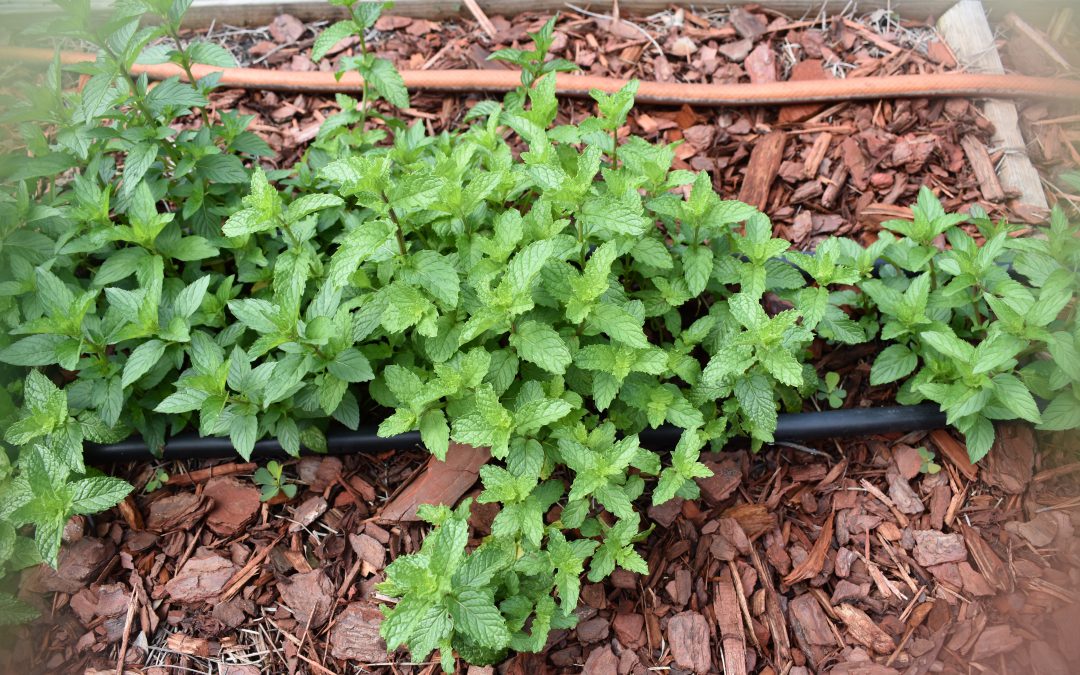
by Matthew Orwat | Jul 15, 2019
So far, the summer of 2019 has been very hot and humid. Plant heat stress was compounded due to this year’s extremely dry spring. Fortunately, there are several herbs that can tolerate drought and heat, and some even thrive on it. Here are a few herbs to think about trying this summer.
Lavender
Lavender thrives in low organic matter soils that are also well drained. Sometimes small rocks are added to the soil to improve drainage if the soil drains poorly. If the garden is mulched, make sure the mulch is several inches away from the main stem, since fungal stem rots are common in humid climates. Ed Gillman notes, in his EDIS publication FPS-337 on lavender that lavender is very sensitive to pH, and that it should be kept above 6. This is particularly noteworthy since many soils in the Florida panhandle are very acidic, at pH 5.5 or below. Lavender grows between two to three feet tall generally, but smaller cultivars exist as well. It does not respond well to excess irrigation, so make sure it is not sited next to water thirsty plants like basil. While lavender is drought and heat tolerant, a little afternoon shade during the hottest parts of summer is welcome.
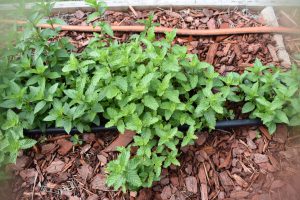
Mixed mint in raised bed, Photo by Matthew Orwat
Mint
There are many different kinds of mint available to the herb gardener, but the most common types are spearmint and peppermint. Mint thrives in the heat when well-watered and will also recover from drought conditions quickly. When planting mint, consider segregating it from other herbs, since it tends to take over any area it’s given. Raised beds are ideal for mint since the borders of a raised bed will keep it in bounds.
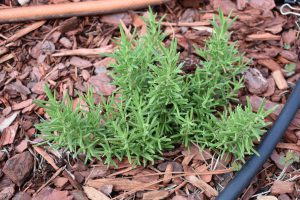
Rosemary in raised bed, Photo by Matthew Orwat
Rosemary
Like lavender, rosemary is a somewhat woody herb and can persist for several years as a “shrub” in zone 8 or higher. It is as drought tolerant as lavender and also shares its disdain for overwatering. Several cultivars exist, such as the trailing ‘Prostratus’ cultivar. Growers can expect blue to purple flowers in the winter on evergreen plants. For more information about rosemary, see this IFAS Gardening solutions entry.

Variegated lemon thyme leaves, Photograph by Julie McConnell, UF / IFAS
Thyme
The smallest evergreen herb that does well in Northwest Florida is thyme. Thyme doesn’t like to completely dry out, but is fairly drought tolerant and excels in rock gardens, where it can cascade down over stone. It needs well drained soil to thrive and should be sited away from competition from other plants. See this Gardening Solutions page for more information
























